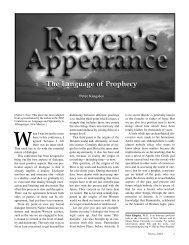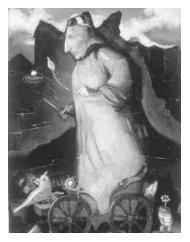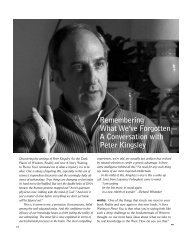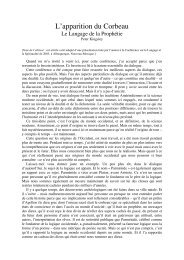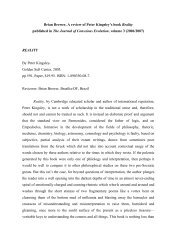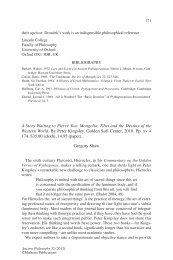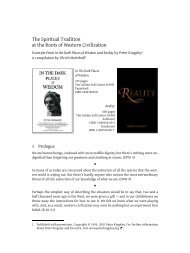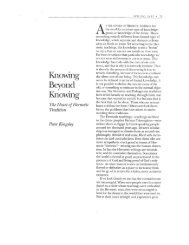92-121 Reviews layout 3/22 - Peter Kingsley
92-121 Reviews layout 3/22 - Peter Kingsley
92-121 Reviews layout 3/22 - Peter Kingsley
Create successful ePaper yourself
Turn your PDF publications into a flip-book with our unique Google optimized e-Paper software.
<strong>92</strong>-<strong>121</strong> <strong>Reviews</strong> <strong>layout</strong> 3/<strong>22</strong> 5/12/04 9:<strong>22</strong> AM Page 106<br />
106 • PARABOLA<br />
THE QUEEN OF HEAVEN<br />
IS ALIVE AND WELL IN . . .<br />
TREASURES<br />
OF<br />
THE<br />
Holiday Stories<br />
That Reveal<br />
the Soul of Judaism<br />
HE ART<br />
DIANE WOLKSTEIN<br />
“Wolkstein brings her poetic<br />
insight to the Bible stories.... Like<br />
Inanna, Queen of Heaven and Earth,<br />
which changed our perceptions<br />
of the ancient world,<br />
Treasures of the Heart is<br />
a daring and important book.”<br />
—Grace Paley<br />
SCHOCKENBOOKS www.schocken.com<br />
removed from the texts themselves: it is<br />
words about pictures about words. In closing,<br />
then, I return to the fascinating and<br />
inspirational texts that are the basis of the<br />
series. Some of these sacred words are hard<br />
to come by, hidden away in large anthologies<br />
and arcane sources. Shambhala has<br />
done well in making them available in an<br />
attractive and affordable format. Even in an<br />
over-lavish page, the simplicity, directness,<br />
beauty, and wisdom of the texts will call<br />
readers back to each volume. As well as an<br />
interesting, if flawed, presentation of examples<br />
of contemporary calligraphic art, the<br />
books in this series would function well as<br />
sourcebooks for contemplation.<br />
An art historian and member of the Western<br />
Buddhist Order, Manjusura (Ian Tromp) has<br />
written essays and reviews for the (London)<br />
Times Literary Supplement, Tricycle,<br />
Buddhadharma, and The Nation.<br />
Reality<br />
By <strong>Peter</strong> <strong>Kingsley</strong>. Inverness, Calif.: The<br />
Golden Sufi Center, 2004. Pp. 600. $35.95,<br />
cloth; $19.95, paper.<br />
Reviewed by Seyyed Hossein Nasr<br />
The book Reality by the British scholar<br />
of Greek philosophy, <strong>Peter</strong> <strong>Kingsley</strong>,<br />
unveils a reality which, if understood and<br />
accepted, will transform the understanding<br />
of contemporary Western humanity of itself<br />
and of the roots of Western civilization. It is<br />
for that reason an exceptionally challenging<br />
and at the same time salient work. Since the<br />
rise of the Renaissance understanding of<br />
Greek thought, the rationalism inherent in<br />
its humanistic vision has depicted Greek philosophy<br />
as almost synonymous with the rise<br />
of rationalism and the divorce of logic from<br />
the domains of the mysterious, the mystical,<br />
and the supra-rational. As the history of<br />
philosophy developed in the West within<br />
the matrix of the paradigm created by the
<strong>92</strong>-<strong>121</strong> <strong>Reviews</strong> <strong>layout</strong> 3/<strong>22</strong> 5/12/04 9:<strong>22</strong> AM Page 108<br />
108 • PARABOLA<br />
Books on Advaita,<br />
Tantra, and Dzogchen<br />
by Richard Chambers Prescott<br />
The Mirage and the Mirror<br />
(Thoughts on the Nature of<br />
Anomalies in Consciousness)<br />
Including The Goddess and the God<br />
Man (on Kali and Ramakrishna),<br />
The Lamp of the Turiya (Waking,<br />
Dream, Deep Sleep and the Fourth<br />
State of Consciousness), and<br />
Cremating the Subtle Body in the<br />
Luminosity of Consciousness.<br />
ISBN 1-58500-<strong>121</strong>-X<br />
Inherent Solutions To<br />
Spiritual Obscurations<br />
(A text emphasizing the Divine<br />
Mother). Including The Wonder of<br />
the Dakini Mind, Letting Go and<br />
Soaring On, Resolution in Pure Mind<br />
and The Ancient Method. (Trekchod,<br />
Thogal, Amanibhava, Gaudapada,<br />
Janaka, and the Upanishads)<br />
ISBN 1-58500-405-7<br />
Disturbing Delights:<br />
Waves of the Great Goddess<br />
(With Quantum Kamakala: Seeking<br />
the Mysterious in Hidden Tantric<br />
Superstructures and Quantum<br />
Superstring Theory) On Sri Vidya and<br />
Advaita Vedanta. Including 180<br />
Subject Titles. Sankhika and Mystery<br />
Worship, Cosmology and Reality.<br />
ISBN: 0-75963-416-5<br />
Measuring Sky<br />
Without Ground<br />
(On the Goddess Kali and Human<br />
Potential). A Pragmatic Psychology<br />
of Non-Duality. Including Because of<br />
Atma, Great Delight, The Deathless<br />
Self and the Dramatics of the Psyche,<br />
Sahaja Sakti, Bhavamukha, and<br />
Inextinguishable Feeling.<br />
ISBN 1-58721-571-3<br />
Swami Gokulananda, Ramakrishna Mission, New Delhi:<br />
“We deeply appreciate the monumental work that you<br />
have done in bringing out this publication.”<br />
Dr. Stanley Krippner, Saybrook Institute: “I read your<br />
splendid book this week. It is a solid contribution to the<br />
literature and I will recommend it to our students.”<br />
Request Print On Demand<br />
At Any Fine Bookstore<br />
Ingram Book Co. or www.1stbooks.com<br />
Available in Hardcover, Paperback, or e-Book<br />
Renaissance and the Scientific Revolution,<br />
the pre-Socratics came to be seen as men<br />
groping gradually forward on the road that<br />
led in the fourth century b.c.e. to Platonism<br />
and Aristotelianism. Among these figures<br />
Parmenides was seen as being especially<br />
important as the founder of logic and, for<br />
many, of philosophy itself. And in more<br />
recent times famous philosophers from<br />
Nietzsche to Heidegger have turned to the<br />
pre-Socratics to provide new interpretations<br />
of the foundations of Western thought.<br />
<strong>Kingsley</strong> turns all these interpretations<br />
on their head and with careful analyses of<br />
the surviving Greek texts as well as archaeological<br />
findings is able to present a completely<br />
different picture of these figures,<br />
especially Parmenides and Empedocles,<br />
with whom most of the book is concerned.<br />
He demonstrates convincingly that, far<br />
from being the father of logic as understood<br />
today and a mediocre poet, Parmenides<br />
was a priest of Apollo, an iatromantis<br />
and a prophetlike figure who through the<br />
process of incubation and utter stillness was<br />
led like a shaman to the other world, while<br />
being still alive here on earth, and was<br />
taught by the goddess the meaning of true<br />
philosophy, which is a means of transformation<br />
of one’s being rather than mental acrobatics<br />
and which cannot be learned unless<br />
one dies before dying. For as Plato said,<br />
“Philosophy is the practice of death.” To<br />
quote <strong>Kingsley</strong> in referring to the current<br />
study of much of philosophy, “Now it [philosophy]<br />
has just come to mean the love of<br />
endless talking and arguing about the love<br />
of wisdom—which is a complete waste of<br />
time. Philosophy is a travesty of what it once<br />
was, no longer a path to wisdom but a<br />
defense against it.” He demonstrates that<br />
the phrase krinai logôi (“judge by reason”)<br />
used by Parmenides does not at all mean<br />
defense of rationalism for here, a century<br />
before Plato, logôi did not mean reason but<br />
word or speech from which truth emerges<br />
as when the Book of John says, “In the<br />
beginning was the Word (logos).”<br />
Another term central to Parmenides and
<strong>92</strong>-<strong>121</strong> <strong>Reviews</strong> <strong>layout</strong> 3/<strong>22</strong> 5/12/04 9:<strong>22</strong> AM Page 110<br />
110 • PARABOLA<br />
PARABOLA Storytime Series ® for children of all ages<br />
THE BOY WHO LIVED WITH THE BEARS<br />
And Other Iroquois Stories by Joseph Bruchac; illust. by Murv Jacob<br />
■ Color Illust; 63pp; $11.95<br />
■ Color Illust; 78pp; $12.95<br />
Buzzard flies to the Creator to bring back clothes for<br />
all the birds. Tiny Chipmunk takes on massive, powerful<br />
Bear in a challenge to determine whether or not<br />
the sun will keep rising. In the title story, a young boy<br />
has lost his human family and finds love in the home of<br />
the Bears. Wise and foolish, cowardly and brave, animals<br />
teach humans how to live better lives in these instructive<br />
and entertaining traditional tales.<br />
“A must-have for anyone interested in storytelling tradition and<br />
Native American oral literatures.” —Ursula K. Le Guin<br />
HOW RABBIT TRICKED OTTER<br />
And Other Cherokee Trickster Stories<br />
by Gayle Ross; illustrated by Murv Jacob<br />
This collection of 15 Cherokee tales, from a time when<br />
animals and people still spoke the same language,<br />
introduces Rabbit, the most important character portrayed<br />
in the animal stories of the Cherokee culture. A messenger<br />
who carries important news to his animal friends, Rabbit<br />
is charming and mischievous—he tricks others and is often<br />
tricked himself, but somehow Rabbit always survives.<br />
PARABOLA BOOKS 656 Bway, NY, NY 10012<br />
Orders / free catalog: www.parabola.org<br />
1.800.560.6984 / 212.505.6200<br />
Socrates is elenchus, which does not mean<br />
simply the process of reasoning but, to quote<br />
<strong>Kingsley</strong> again, “the process of demonstrating<br />
the truth about a matter . . . of getting to<br />
what is real at all costs.” He believed in fact<br />
that he was ordered to follow this process by<br />
divine command as did Socrates. As for the<br />
poem of Parmenides, far from being mediocre<br />
poetry, it is shown to be not only a vehicle<br />
for the exposition of the truth of philosophy,<br />
but an operative aid for the realization<br />
of that truth, of a philosophy which must be<br />
considered as sacred knowledge.<br />
The first five parts of Reality deal mostly<br />
with Parmenides and to some extent his<br />
student Zeno and also Socrates. From Part<br />
Six on, the author turns to Empedocles,<br />
who is shown to be not only a cosmologist<br />
and physicist but also a prophet and sorcerer<br />
who combined science with mysticism<br />
and considered philosophy to be an esoteric<br />
science meant only for the few qualified<br />
to understand it as is clearly stated at<br />
the beginning of his poem. As we see in the<br />
case of Islamic cosmology, for Empedocles,<br />
all his cosmology and science was “to help<br />
us learn what we really are and be free.”<br />
<strong>Kingsley</strong> indicates that the teachings of<br />
Empedocles, who followed the line of<br />
Parmenides, although not well understood<br />
in the West, were continued in Egypt and<br />
from there reached the Islamic world. It is<br />
in fact remarkable how close the interpretation<br />
of these figures by <strong>Kingsley</strong> is to that of<br />
certain early Sufis and Islamic authorities<br />
such as Suhrawardi, Shahrazuri, Mulla<br />
Sadra, and Qutb al-Din Ashkiwari. It would<br />
be a groundbreaking work of scholarship<br />
to collect such selections from Arabic and<br />
Persian, translate them into English, and<br />
make a systematic comparison between<br />
them and what <strong>Kingsley</strong> has uncovered in<br />
this and his other works. There is certainly<br />
no doubt that Islamic philosophers had<br />
a line of access to Greek philosophy and<br />
understanding of its meaning, especially
<strong>92</strong>-<strong>121</strong> <strong>Reviews</strong> <strong>layout</strong> 3/<strong>22</strong> 5/12/04 9:<strong>22</strong> AM Page 111<br />
SUMMER 2004 • 111<br />
■ Paperback, 242 pp; $14.95<br />
NEW!<br />
THE NATURE OF HEALING draws on a variety of cultures,<br />
traditions, and sciences to offer powerful perspectives on<br />
health and healing, disability and disease, doctors and doctoring,<br />
Eastern and Western medical theories and treatments,<br />
and, finally, consciously confronting the inevitability of<br />
death. With a primary focus on the transformative nature<br />
of disease and the metaphorical dimension of healing,<br />
THE NATURE OF HEALING is an invaluable<br />
resource in understanding the healing process.<br />
A much-expanded version of PARABOLA<br />
Magazine’s HEALING issue, includes selections<br />
by philosophers, poets, scholars, psychologists,<br />
thinkers and theologians, from Hippocrates and<br />
John Donne to Carl Jung and Thich Nhat Hanh.<br />
from PARABOLA Books<br />
THE NATURE OF HEALING<br />
Writings from the world’s spiritual traditions<br />
Edited by PARABOLA Magazine<br />
Foreword by Larry Dossey, M.D.<br />
selections include:<br />
• The Alchemy of Illness<br />
• Healer Within<br />
• Including Even Our Mad Parts<br />
• Healing in Ancient Egypt<br />
• Navajo Sand Paintings<br />
• Images of Wholeness<br />
• Transforming Our Suffering<br />
• The Path of the Departing Soul<br />
A haunting tone poem whose golden beat is the age-old search for the elusive<br />
and hidden powers of sickness and cure. —Whole Earth Review<br />
Orders / free catalog: www.parabola.org<br />
1.800.560.6984 / 212.505.6200<br />
PARABOLA BOOKS 656 Bway, NY, NY 10012<br />
the pre-Socratics but also Plotinus, independent<br />
of the philosophical understanding<br />
in the modern West based solely on<br />
fragments of Greek texts that have reached<br />
the West.<br />
Since the 1960s many have spoken of<br />
a paradigm shift in the West and there is<br />
little doubt that the life of the paradigm<br />
created in Europe in the Renaissance and<br />
the seventeenth century is now coming to its<br />
end. <strong>Kingsley</strong>’s book is a major step in this<br />
process for it presents a completely different<br />
understanding of the foundations of Western<br />
thought from what has been promoted<br />
by the majority of classicists and philosophers<br />
in the West during the past five centuries.<br />
For that very reason the book is<br />
bound to meet great resistance from standard<br />
bearers of prevalent interpretations<br />
of such seminal figures as Parmenides and<br />
Empedocles. But also for that very reason it<br />
is a book of singular significance, especially<br />
for those in search of understanding beyond<br />
the confines of a rationalism and an irrationalism<br />
both of which have become stale.<br />
The book is long but it reads like an<br />
exciting novel, at least for those in search<br />
of a truth that transforms and not simply<br />
of information that clutters the mind. The<br />
scholarly paraphernalia are kept at the end<br />
of the book and the text is written in a vivid<br />
prose without scholarly jargon in such a way<br />
that it is accessible and should be highly<br />
attractive to the concerned educated reader<br />
even if he or she does not have a background<br />
in philosophy, for it deals with<br />
truths which are of the greatest existential<br />
importance, truths whose understanding is<br />
literally a matter of life and death.<br />
Seyyed Hossein Nasr is author of over twenty<br />
books and over two hundred articles. His works<br />
concern not only aspects of Islamic studies but<br />
also comparative philosophy and religion, philosophy<br />
of art, and the environmental crisis.




